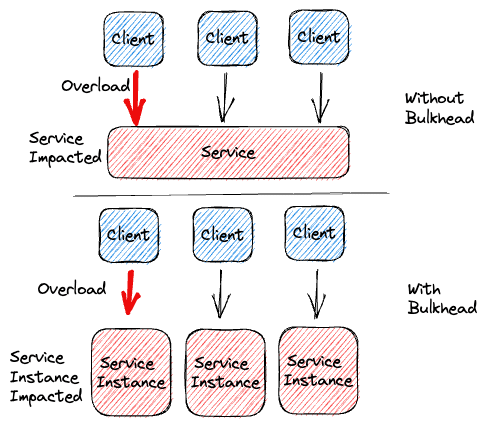Bulkhead Pattern System Design
In this tutorial, we are going to discuss about the Bulkhead Pattern System Design Examples. Designing a system with the Bulkhead Pattern involves creating a resilient architecture that isolates different components or services to prevent failures in one area from affecting the entire system.
The Bulkhead pattern finds its footing in an array of distributed system scenarios. It’s a pattern that parallels real-world applications, as it’s inspired by a naval architecture concept. But how do these ship compartments translate into software systems? Let’s illustrate this through some real-world use cases.

Use Cases
E-Commerce Platforms
Let’s imagine an e-commerce platform, where customer actions can span searching for products, adding items to their carts, and placing orders. While these operations are interconnected, they can be performed independently.
Now, what if the service handling search operations is overwhelmed due to a spike in traffic or a bug causing excessive load? Without bulkheading, this could slow down the entire platform, affecting even cart and ordering services. This is where the Bulkhead pattern comes in handy. By isolating services into separate bulkheads, we ensure that an issue in one does not impact the others.
Online Gaming Platforms
An online gaming platform could be another perfect use case. Suppose the platform offers various games, each running as a separate service. Player requests to one game shouldn’t affect the performance of the other games. Again, by isolating game services into separate bulkheads, we can prevent a faulty or overloaded game from affecting the entire platform.
Financial Systems
Financial systems often have distinct operations: account management, transaction processing, and reporting. These operations are interrelated but can also function independently. A delay in generating reports shouldn’t affect the speed of transaction processing. Implementing the Bulkhead pattern can isolate these services, ensuring smooth and unaffected operations.
System Design Examples
Understanding the Bulkhead pattern through theoretical use cases is good, but let’s solidify this understanding with a system design example.
Consider a large-scale music streaming platform like Spotify. This platform includes multiple services such as music streaming, user management, playlist management, and recommendation generation.
Now, let’s think about how we could apply the Bulkhead pattern to this system:
Bulkheading Services
In our music streaming platform, the user management service could be completely isolated from the music streaming service. That way, even if the user management service were to become overloaded due to a sudden surge in new users, this would not affect the performance of the music streaming service. Users would still be able to listen to music uninterrupted.
Similarly, the playlist management and recommendation services could also be isolated into their own bulkheads. So, even if the recommendation service becomes slow due to the complexity of processing and analyzing user data, the playlist management service won’t be affected, and users will still be able to create and manage their playlists.
Bulkheading at a Lower Level
We could also implement bulkheading at a lower level within a service. For example, within the music streaming service, we could separate the task of fetching a song from the task of streaming the song to the user into separate thread pools. So if fetching songs becomes slow due to a delay in accessing the song database, this won’t slow down the streaming of already fetched songs to the users.
In both examples, applying the Bulkhead pattern can dramatically increase the resilience of the system. While one service or task is slow or failing, others continue functioning normally, providing an uninterrupted user experience.
Whether it’s an e-commerce platform, a gaming platform, or a music streaming service, the Bulkhead pattern can enhance system resilience significantly. So, can you think of any services in your system that could benefit from this isolation? Or perhaps you can see now how existing slowdowns or failures could have been prevented with the Bulkhead pattern.
That’s all about the Bulkhead Pattern System Design. If you have any queries or feedback, please write us email at contact@waytoeasylearn.com. Enjoy learning, Enjoy Microservices..!!